Blessed Are Those in Cuba Who Have Faith
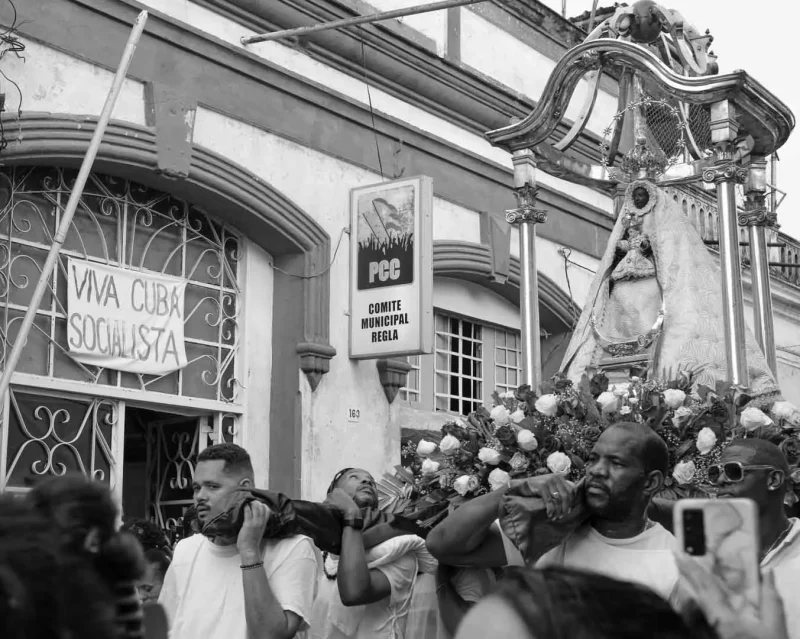
Text and photos by Nester Nuñez (Joven Cuba)
HAVANA TIMES – Mercedes is waiting for the ferry to cross the bay. A scarf covers her hair, now gray at 54 years old. She holds a cheerful fan and wears a calm smile despite the heat, the noise of the crowd, and the delay. “I come every year,” she says. “My grandmother used to bring me when I was little.”
On the other side of the fence, a mother sits on a bench with her two small children. In the space on the right side of the photo, where storm clouds threaten rain, the absence of the father and husband is highlighted. One can’t help but think they will kneel before the Virgin, holding back tears, and with their hearts in their hands, they will pray for health, strength, and for their family to be reunited once again.
It’s September 7, the day of the Blessed Virgin of Regla, patron saint of the Port of Havana. At 5 p.m. there will be a mass in the church, and afterward, a procession will make its way through part of the town. “A lot of people make wishes to her because they have faith. Faith is what saves us, even if it’s a lie,” says Mercedes.
The gate to the dock opens, and the blue dolls are raised above people’s heads so they won’t be damaged. The voices, the sound of cars, and footsteps on the pavement suddenly fall silent, like in a movie, and only the unified, vaulted chant that gives motivational strength can be heard:
“Row, row, row… for the Virgin of Regla will accompany us.”
The effort is yours, it’s up to you to move the boat of your life forward, but there is comfort in the Virgin’s accompaniment, in something with an origin beyond understanding that can only be embraced with faith. Absolutely, you are not alone.
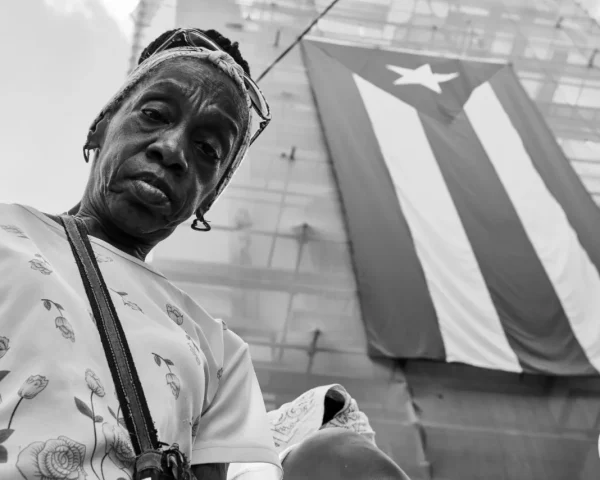
The main façade of the Church of Our Lady of Charity, in Central Havana, is covered by a green mesh, like a large mosquito net that safeguards it from tropical diseases. A gigantic Cuban flag hangs from it, waving over the sunflowers and yellow dresses, and over the Virgin who will soon go out on pilgrimage, adorned with red, blue, and white balloons. The inside of the church is as crowded as the surrounding streets. The faithful pray in silence, light their candles, and offer their gifts on this September 8.
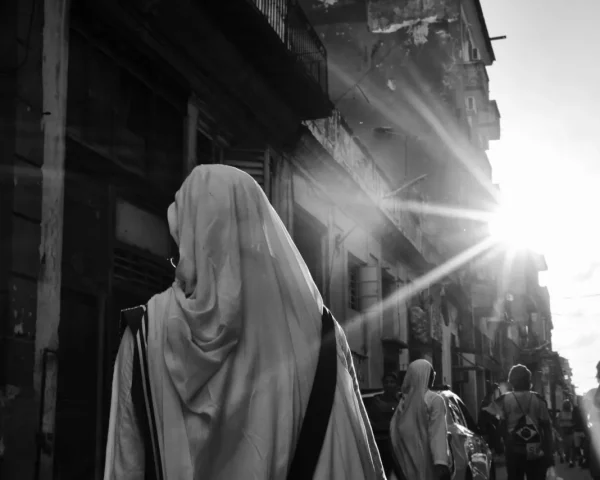
From their high balconies and rooftops, the neighbors of Galiano and Reina Streets will have a broader view of the procession, though they will never match the perspective of the superior being many believe in. He is above all things and at the same time within each of us, they say. To His eternal time, our passage on Earth is but a scratch in the dust, like the buildings in Havana that crumble and turn into garbage heaps before disappearing from memory and remaining only in photographs.
The faithful go to “Cachita” and the children of Oshun mix in celebration and harmony. With luck, they will remain in the memories of their loved ones. Immortality is denied to us. Many simply long for health and strength to endure the present.
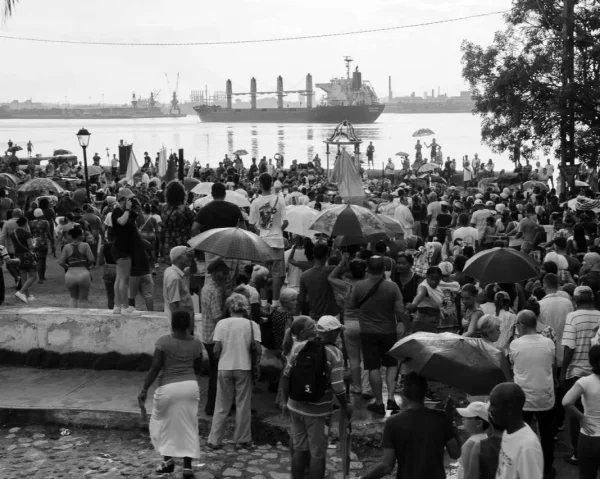
From the procession of the Cabildo, once again in the municipality of Regla, the four saints and the drums stand out. Only once a year did the Spanish authorities allow the slaves to venerate their gods. The 12th is a day of celebration. It’s a parade under the scorching sun. Those brought from Africa were the strongest and healthiest of their tribes. Of them, the weakest died due to the conditions of the sea journey. Of those who touched land, the less strong perished from the brutal work in the sugarcane fields. What remained was the best of the best of Africa; they mixed with each other and with the Spanish. That is, for the most part, the race we are. To survive, the Black gods had to camouflage themselves for centuries in the religious creed imposed by power, although it was not the majority.

Perhaps that same instinct for survival is what still today, in matters related to authorities, leads us to say one thing while in reality, we think, feel, and desire the complete opposite. If we locate the formation of national identity, of Cuban consciousness, at the beginning of the 19th century, we are a very young nation in the eyes of human history. God gave us free will, they say, so we are responsible for our own decisions and for our individual and collective actions. Hopefully, we will mature soon, and it won’t take generations upon generations before we act accordingly, to change what must be changed.
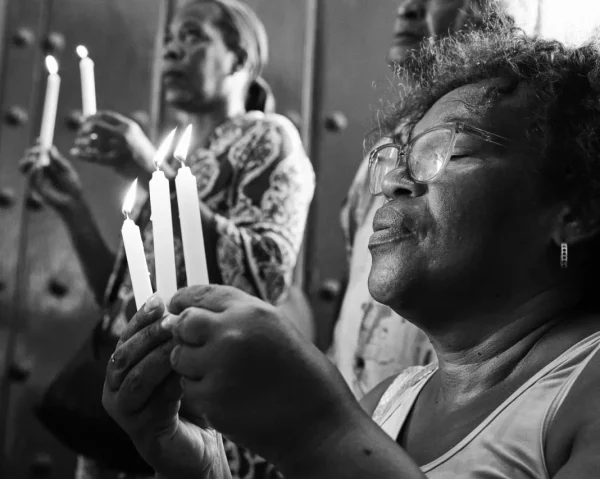
The future is open to endless possibilities that we do not know.
There are those who train, condition, and lull their minds with an absurd prayer: everything is going to be okay. Perhaps in this way, they attract the good, according to theories. It may also be that excess optimism prevents them from preparing to face negative events. One thing is hope, and another is blind faith. Blind faith is less abundant among Cubans, and hope is increasingly limited to personal and family projects. As a society, we have stopped expecting anything good to happen.
Those who have faith accept the existence of something greater that escapes human understanding and will.

Those who have faith let go of some control over their lives, receive help, and open themselves more to the mystery of existence. It is very difficult to accept that we are the ones ultimately responsible for what happens to us.
Faith manifests itself in many ways. There are those who pray, those who plant or embrace trees, those who light candles, those who doubt themselves and then regain self-esteem, those who go to sacred places, those who clean the oceans, those who make sacrifices and promises, those who connect with the spirit of the dead, those who meditate cross-legged, those who, scared of everything, take refuge in their children and continue to trust in human betterment and the usefulness of virtue.
Among the most beautiful aspects of humanity is the diversity of beliefs.






